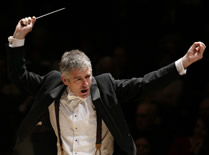The Chamber Orchestra of the Triangle performed the third of their five concerts planned for this season, which means there are two concerts to come and you are certainly encouraged to put those dates (March 14 and May 16) on your calendar right now. The pleasure of hearing this group is the pleasure of appreciating basic musicianship. Over the past 22 years under the direction of Lorenzo Muti they have developed a precision of ensemble and unanimity of phrasing that is well nigh impeccable. Entrances are solid, tempo changes are smooth, and feeling for the meaning of the music is everywhere evident.
The concert was an interesting mix of styles encompassing late 19th century and early 20th century romanticism. The opening selection by Hugo Wolf provided a rare glimpse into the symphonic ambitions of this composer best known for his art song mastery. “Italian Serenade” began its life as a string quartet in 1887. It has elements of pastoral beauty interspersed with a variety of characteristic solos, some of them playful, some gentle and some mischievous, as though they are characters in a story. He orchestrated the work in 1892, the year he published his Italienisches Liederbuch, and it relishes in the sunny sound of Italy. The performance by the COT was accomplished and graced with very fine solo work from the principals.
The soloist for the Chopin Piano Concerto No. 2 in F minor was the young German pianist Benjamin Moser. He began his piano studies in Munich at the age of five and studied at the Hochschule für Musik. He debuted in the Young Concert Artists Series at Carnegie’s Zankel Hall and at the Kennedy Center in Washington.
The concerto opens with an orchestral introduction leading to a heroic theme first played by the soloist and then developed as it is handed back and forth. The first movement, marked Maestoso, was an exquisite example of teamwork. The Larghetto second movement was like a gentle love song tugging at the heart with all of Chopin’s charm and charisma. The Chopinesque turns and trills and runs were a masterful enhancement of the beautiful lyrical melody. The third movement, Allegro vivace, was a tour de force, a whirling mazurka, with Moser’s fingers dancing up and down the keyboard with lightning speed and graceful precision.
For an encore, Moser treated the audience to a stunning interpretation of the well-known “Minute Waltz” (in about two minutes and ten seconds — which is pretty much par for the course). The audience was well pleased with this young artist, and glowing comments were heard during the intermission.
The second half of the concert opened with a luminescent rendition of Jan Sibelius’ “Valse Triste,” originally part of incidental music for a Finnish drama but almost always performed as a stand-alone piece. The story has been told that Sibelius, in one of his frequent spells of low self-esteem, gave the piece to his publisher without copyrighting. It, of course, went on to become one of his most frequently performed pieces. Like most of Sibelius’ music, it sets a wistful and provocative mood brilliantly. The COT is supreme in their handling of this type of music.
Closing the concert was Zoltan Kodály’s Dances of Galanta. One of Kodály’s best known works, this piece captures the mood of the Hungarian Gypsies he heard as a child and the folk music he dedicated his life to collecting. The COT maintained the sense of excitement, vigor, and charm through complex authentic folk rhythms, driving off-beats, and sensuous songs of longing and loving.
This is a band well worth hearing anytime, and Maestro Muti’s casual and informative introductions add much to the pleasure of the music.












